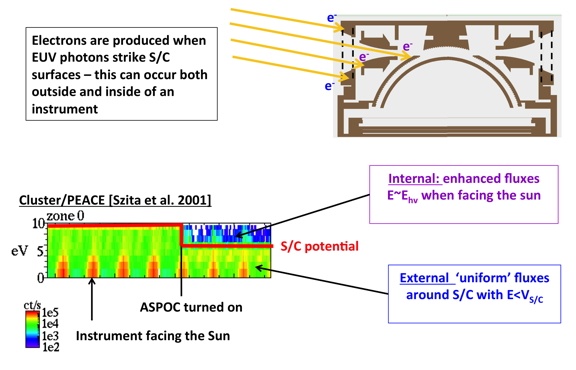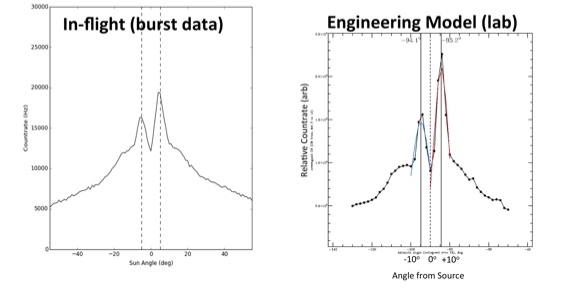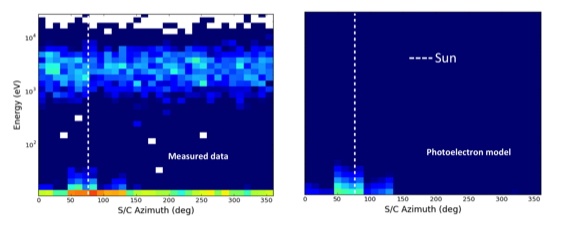Secondary electrons are produced when EUV photons strike spacecraft and instrument surfaces. As shown below in Figure 1, there are two populations of photoelectrons measured at low energies by electron sensors.
- Spacecraft photoelectrons are measured by DES at energies below the spacecraft potential. The spacecraft potential is measured and reported by the electric field double probe. The potential is plasma and spin-phase dependent and approximately uniform across the spacecraft. When the spacecraft controller (ASPOC) is activated, the spacecraft potential decreases as do the energies of spacecraft photoelectrons.
- Secondary electrons produced inside the instrument are measured at low energies independent of ambient plasma or spacecraft potential. The fluxes of these secondary electrons maximize when a given instrument is facing the Sun and are present independent of ASPOC operation.
| Figure 1. (top right) Illustration of photoelectron production in DES. (bottom left) Cluster/PEACE data demonstrate the sensitivity of each population to spacecraft potential (Szita et al. 2001, Cluster PEACE observations of electrons of spacecraft origin, Ann. Geophys.) |
Correcting for Spacecraft Photoelectrons
Assuming a spherically symmetric potential, FPI moments are corrected for spacecraft potential effects. First, instrument measured counts are converted to phase space density at the measured energies. The target energies of these phase space densities are then shifted by the spacecraft potential averaged over a DES (E-Vsc) or DIS (E+Vsc) scan time. Energy channels in DES whose shifted energies become negative (i.e., are below the spacecraft potential) are excluded from the moments integration. In this approach, every FPI scan has a different set of effective energy targets. This approach is equivalent to adjusting phase space densities and using a constant set of energy targets [see Lavraud and Larson 2016, Correcting moments of in situ particle distribution functions for spacecraft electrostatic charging, J. Geophys. Res.: Space Phys.].
Correcting for Internally Generated Photoelectrons
Burst data obtained during commissioning in the hot plasma sheet in the absence of a significant field-aligned electron population were used to characterize the internally generated photoelectrons as a function of energy, deflection state, polar angle, and spinphase. This model is available as a CDF for users interested in estimating the impact of internally generated photoelectrons on their analyses. Photoelectron skymaps [32x16x32] in units of phase space density, denoted as fphoto, are provided as a function of energy table and spacecraft spin phase.
There are subtle changes in the photoelectron fluxes as a function of spacecraft spinphase because the EUV from the Sun has different incident angles to each analyzer. A comparison of the derived photoelectron model with spacecraft data as well as with laboratory testing is shown below in Figure 2. There is a double peak in each analyzer with respect to the angle of incidence of EUV photons due to the large deflection plates used that readily reflect light further into the instrument. The signal from the photoelectrons shown in Figure 3 is measureable up to ~100eV, though is most prominent at the lowest energies (i.e., <50eV).
| |
| Figure 2. (left) Burst data collected on-orbit and (right) laboratory data binned by Sun-instrument angle. Two peaks are observed that correspond to light reflection from DES deflector plates. The asymmetry is caused by asymmetric paths of light into the DES top-hat from the deflectors. | |
Figure 3. (left) Measured data during MMS commissioning of photoelectrons. (right) Model of internally generated photoelectrons. Data are uncorrected, pixel averaged, and ordered by spacecraft azimuth and energy. The vertical white line denotes the anti-sunward direction. In the measured data, spacecraft photoelectrons are observed in the low energy channels and hot plasma sheet electrons are observed at ~2keV. The internally generated photoelectrons show multi-peaked structure and spin-phase dependence due to the evolving angles of incidence of the sunlight on each of the 8 DES sensors. |



